North Vietnam, Fish, September 10th, 1963, Michel Nr. 270-274; Five values were issued. 12 xu (3 stamps), 20 xu and 30 xu. The stamps were issued both perforated (11:0) and im-perforated. Below is the official Xunhasaba bulletin that was released upon announcement of the set and the souvenir sheet. Note that only 15,000 imperforate sets and souvenir sheet were produced. It appears though that the souvenir-sheet was not released together with the stamps as it appeared in the market at a much later date (see notes below).
Here is the mint perforated set: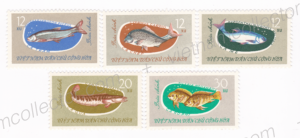
This is the mint imperforate set all uniform from the bottom selvage: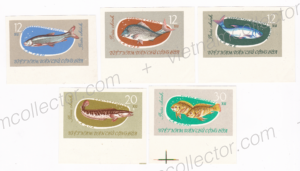
Michel and Scott report that a souvenir sheet was issued with the stamp of the 20 xu value (only perforated) but this is not very likely. While the souvenir-sheet was included in the stamp announcement (see above) it appeared much later in the market than the stamps. Theo Klewitz, the well known Vietnamese philatelist, who reported on new Vietnam issues to the Society of Indochina Collectors (SICP) in their journal wrote the following in SICP Journal Nr. 97 from September/October 1989: ”
“Before continuing with the description of the stamps issued after October 15, 1986, where we left off in the last issue of The Indo-China Philatelist, I want to mention the find of a small sheetlet of the 20 XU value, issued with the fish-series of 1963 of NORTH VIET NAM. This small sheetlet was totally unknown in the Western World and may have been printed as a proof only or for presentation purpose. No doubt the sheetlet, measuring 65×85 mm, is genuine since the stamp is perforated exactly and has the colors of the single stamp of the 20 XU value of the fish-series. Regardless why it was issued, it’s interesting to find a Vietnamese stamp issued some 25 years ago. See figure 1, below, for an example. This maybe but one of many more to surface as the years go by.”
It is also interesting that the Vietnamese Postage Stamp Catalog does list the stamps but not the souvenir sheet. One would assume the semi-Government body that publishes the Vietnamese catalogue would have better knowledge than other catalogue makers on this subject. Also the editor has never seen a First Day Cover with the souvenir sheet. The only used example (ex Duering) is on a piece that was apparently mailed with a registered letter (fragments of the R-label are still visible) from TPHCM (Ho Chi Minh City = Saigon) in June of 1993 (30 years after the souvenir sheet was supposedly issued). The souvenir sheet is rather highly valued (€70 in Michel) as compared to other souvenir sheets at the time. This is an indication that the sheet was rather rare at some point in time. Most likely the sheet was produced but was not officially issued. However either corrupt postal officials or workers at the printing works started selling sheets into the philatelic market. This trickle became at some point in time a flood as now the sheet is plentifully available and rather inexpensive (it usually sells for under $5). This indicates that at some point the postal authorities decided to use Cotevina or Xunhasaba to sell all souvenir sheets remaining in the archive into the philatelic market. We have seen a similar behavior by the South Vietnamese Post. However, all of them are in mint and none in used condition.
Here is the mint souvenir sheet (Block A7)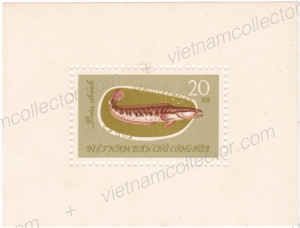
This is the only used example of the souvenir sheet the editor has ever seen in over 25 years of Vietnam stamp collection activity. Since it was used 30 years after the sheet was produced it is likely that the sheet that was technically invalid was accepted by a postal clerk that was not even alive when the sheet was produced.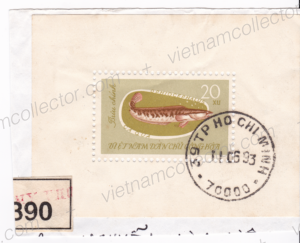
The set comes with a number of perforation errors that occur on all stamps but the 20 xu one.
Here is one of the 12 xu values with bottom selvage that was left im-perforated horizontally in-between stamps.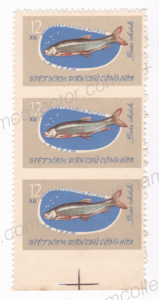
Here is another large piece of the 12 xu values from the bottom right portion of the sheet on which all horizontal perforations are missing.
Here is an impressive piece of the last of the 12 xu values that was left im-perforated horizontally in-between stamps. The item represents the bottom two rows of the sheet.
Finally, this is the 30 xu values with bottom selvage that was left im-perforated horizontally in-between stamps.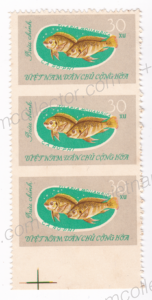
Here is a letter (ex Klewitz) that features the entire perforated set. The letter is franked with 86 xu which would have been insufficient for a registered letter to West Germany (Tariff of 1.1 Dong). However, the clever sender wrote “RD Allemagne” which stood for “Republique Democratic Allemagne” which was the name of East Germany. A standard letter to East Germany was only 12 xu plus the 60 xu international registration fee for an overall required postage of 72 xu. So, the duped postal clerk was rather happy with the 86 xu affixed to the letter.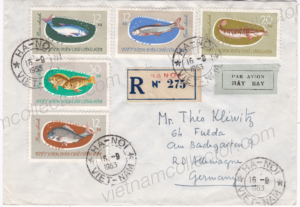
Here is a very rare letter (ex Klewitz) that features the entire im-perforated set. Im-perforated stamps on postally used cover are very hard to find. Most of the im-perfroated stamps ended up unused in the albums of collectors. The letter is franked with 86 xu which would have been insufficient for a registered letter to West Germany (Tariff of 1.1 Dong). However, the clever sender wrote “RD Allemagne” which stood for “Republique Democratic Allemagne” which was the name of East Germany. A standard letter to East Germany was only 12 xu plus the 60 xu international registration fee for an overall required postage of 72 xu. So, the duped postal clerk was rather happy with the 86 xu affixed to the letter.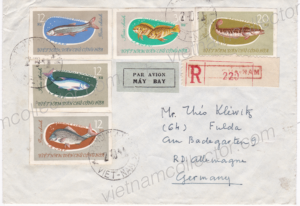
Mixed franking of the 40xu Bird stamp plus the 12xu Fish stamp for an overall postage of 52xu. The standard letter rate to East germany ws only 12xu so this letter must have been much heavier than the standard 20g.
Rare express mail letter with two of the 20 xu and 30 xu stamps stamp sent to Klewitz in November, 1970. The overall franking amounted to 148 Xu or 1.48 Dong which was slightly below the required tariff of a registered express mail letter to West Germany (1.60 Dong tariff). This example goes to show that not all postal clerks were familiar with the entire tariff structure.
Very rare registered express mail letter mailed to Klewitz in July of 1970 featuring the entire im-perforated set. It also shows a pair of the 12 xu im-perforated fish set from 1963. Im-perforated stamps on postally used covers are very rare. The overall postage amounted to 1.60 Dong which was the exact tariff for a standard 20 gram registered express mail letter to West Germany. Fulda arrival cancel on the reverse.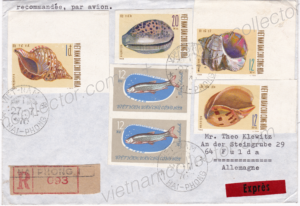
Very rare registered express mail letter sent to Klewitz in July of 1970 featuring the entire set plus two im-perforated stamps of the 1963 fish set (20 xu and 30 xu). Im-perforated stamps on postally used cover are very rare. The overall postage amounted to 1.62 which was just a tad of the required postal tariff of 1.60 Dong. Fulda arrival cancel on the reverse.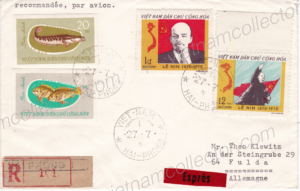
Very rare large envelope mailed registered and via express mail to Klewitz in July of 1972 Apart from a strip of the first 12 xu stamps it also carries im-perforated stamps of the artist and writer as well as the fish stamp set. Im-perforated stamps on postally used cover are very rare. The overall postage amounted to 2.02 Dong which appears to be in line with the postal tariff for such a large envelope.
Very rare registered express mail letter sent to Klewitz in May of 1975. The letter features the set plus a number of im-perforated stamps of the fish set. Im-perforated stamps on postally used cover are very rare. The overall postage on the letter amounted to 2.60 Dong which is above the Tariff of 2.10 Dong, but th heavier may have been heavier than the standard 20 grams.
Mixed franking with the entire set plus other NVN stamps (including two of the Fish set stamps) for an overall postage of 97xu, which was well above the required 12xu tariff in 1964, so most likely this represents a philatelic mailing.
Registration Nr. 100820

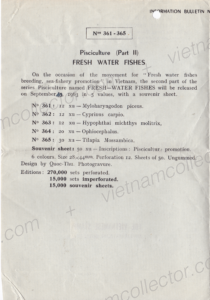
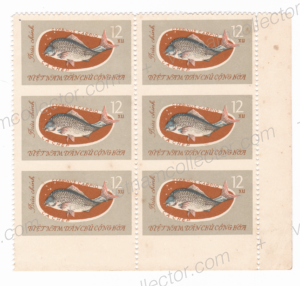
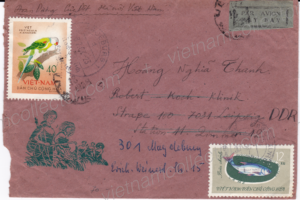
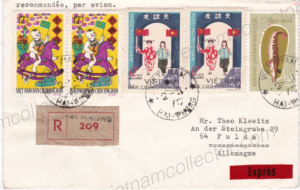
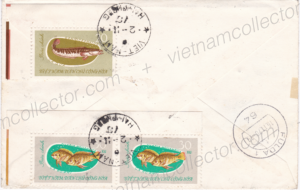
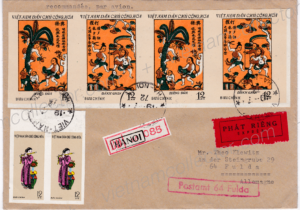
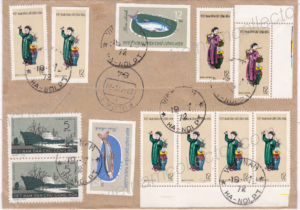
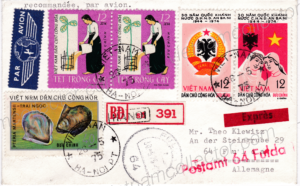
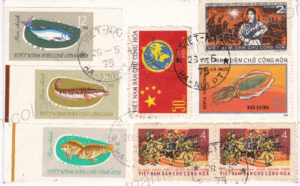
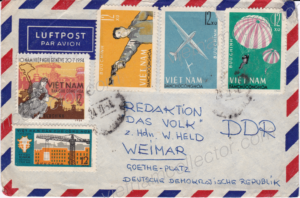
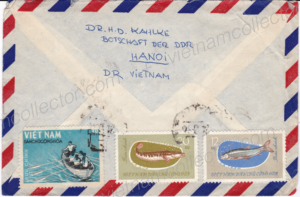
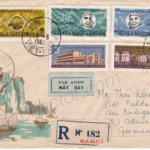
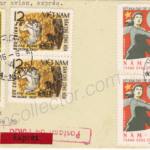
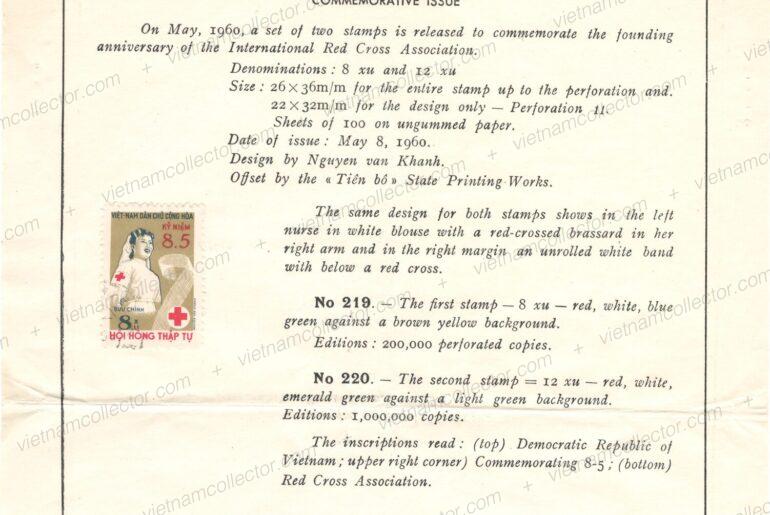
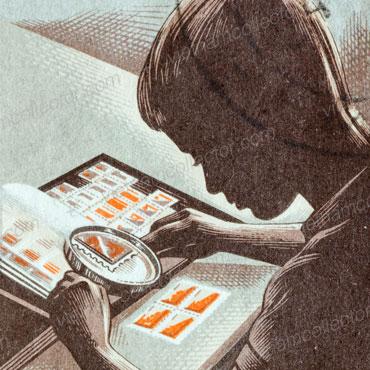
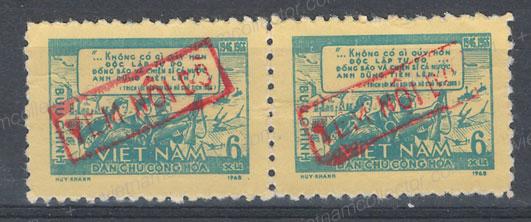
Comments are closed.